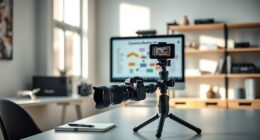In our effort to dominate the online space, we encounter obstacles within technical SEO that might hinder our website’s performance.
Imagine a scenario where broken links and redirects lead users astray, frustrating their journey. Slow page loading times exacerbate their impatience, causing them to abandon ship. Incorrect indexing and crawlability issues prevent search engines from properly understanding our content.
It’s crucial to address these problems, along with mobile responsiveness, duplicate content, meta tag optimization, structured data errors, and SSL certificate security, to ensure our online success.
Key Takeaways
- Technical SEO issues can negatively impact website performance, including broken links, slow page loading times, and incorrect indexing and crawlability.
- Content optimization is important for technical SEO, including addressing duplicate content, optimizing meta tags, and fixing structured data errors.
- Technical SEO is crucial for website security, including ensuring SSL certificate validity and following best practices for website security.
- Implementing technical SEO practices can enhance website visibility in search engines, increase organic traffic, and improve user engagement metrics.
Broken Links and Redirects
When it comes to technical SEO issues, one of the most common and important problems that we encounter is dealing with broken links and redirects. These issues can greatly impact the user experience and the overall performance of a website.

Broken links occur when a hyperlink on a website leads to a page that no longer exists. This can happen due to changes in the website architecture or URL structure.
Redirects, on the other hand, are used to automatically send users from one URL to another. They’re necessary when a page has been moved or renamed. However, if implemented incorrectly, they can result in slow page loading times, which we’ll discuss in the next section.
It’s crucial to regularly monitor and fix broken links and ensure that redirects are properly set up to maintain a smooth user experience and optimize website performance.
Slow Page Loading Times
One of the key technical SEO issues we encounter is dealing with slow page loading times. Slow page loading times can negatively impact user experience, as visitors may become frustrated and leave the website before it even loads. This can result in a high bounce rate and lowered search engine rankings. To address this issue, it is essential to focus on improving server response and optimizing images.

Improving server response involves various techniques such as reducing server requests, leveraging caching mechanisms, and using content delivery networks (CDNs) to distribute website content across multiple servers. Optimizing images includes compressing images without compromising quality, using the appropriate image format, and implementing lazy loading techniques.
By addressing these aspects, website owners can significantly improve page loading times and enhance the overall user experience, leading to higher search engine rankings and increased organic traffic.
| Issue | Solution | Benefits |
|---|---|---|
| Slow page loading | Improving server response | Enhanced user experience |
| times | Higher search engine rankings | |
| Image optimization | Increased organic traffic |
Incorrect Indexing and Crawlability
To address the issue of incorrect indexing and crawlability, we focus on implementing proper website structure and optimizing robots.txt files.
Common indexing errors can prevent search engines from properly crawling and indexing your website, leading to decreased visibility in search results. It’s important to ensure that all pages on your site are accessible to search engine bots and aren’t blocked by robots.txt directives.

Optimizing your robots.txt file can help improve crawlability by allowing search engines to efficiently crawl and index your site’s important pages.
Crawl budget optimization is another crucial aspect of addressing indexing and crawlability issues. By prioritizing the crawling of high-value pages and avoiding duplicate content, you can make the most out of your website’s crawl budget and ensure that search engines are indexing the most relevant and important pages on your site.
Mobile Responsiveness Issues
When it comes to mobile responsiveness issues in SEO, there are two key points to consider: page speed impact and user experience optimization.
Page speed impact refers to the loading time of a website on mobile devices, as slow loading times can negatively affect search engine rankings.

User experience optimization involves ensuring that a website is easy to navigate and interact with on mobile devices, providing a seamless and enjoyable experience for users.
Both of these points are crucial for mobile SEO success.
Page Speed Impact
We experience a significant impact on page speed due to mobile responsiveness issues. Optimizing images and minifying code are two key areas that can greatly improve page speed on mobile devices.
When it comes to optimizing images, it’s important to reduce their file size without compromising quality. This can be achieved by using compression techniques, such as reducing image dimensions and utilizing the appropriate file formats.

Additionally, minifying code involves removing unnecessary characters, spaces, and line breaks, which can help reduce the overall file size of the website.
By implementing these optimizations, we can ensure that our website loads quickly and efficiently on mobile devices, providing a better user experience.
Now, let’s delve into the next section, which focuses on user experience optimization.
User Experience Optimization
One area of concern in user experience optimization is the impact of mobile responsiveness issues.

It’s crucial for websites to be fully optimized for mobile devices in order to provide a seamless and user-friendly experience.
Here are some key points to consider when addressing mobile responsiveness issues:
- Responsive Design: Ensuring that your website is designed to adapt to different screen sizes and resolutions is essential for mobile optimization.
- Page Load Time: Mobile users expect fast loading times, so optimizing your website’s performance is crucial for improving the user experience and increasing conversion rates.
By addressing these mobile responsiveness issues, you can enhance the overall user experience and increase the likelihood of conversions on your website.
Now, let’s move on to the next topic: duplicate content.

Duplicate Content
The most common technical SEO issue encountered is the presence of duplicate content. Content duplication refers to having similar or identical content on multiple pages of a website. This can negatively impact search engine rankings as it confuses search engines about which page to rank for a particular query.
To address this issue, canonical tags can be used. Canonical tags are HTML tags that inform search engines about the preferred version of a webpage when there are multiple versions available. By implementing canonical tags, website owners can consolidate the ranking signals to a single page, avoiding the negative consequences of duplicate content.
It’s important to regularly audit the website for duplicate content and ensure that canonical tags are correctly implemented to maintain a strong SEO performance.
Missing or Poorly Optimized Meta Tags
Often overlooked by website owners and SEO practitioners, missing or poorly optimized meta tags can significantly impact a website’s search engine optimization efforts. Meta tags are HTML elements that provide information about a webpage to search engines and website visitors. They play a crucial role in improving a website’s visibility and click-through rates.

Here are two reasons why meta tags are important in SEO:
- Enhanced search engine visibility:
- Meta tags, such as the title tag and meta description, help search engines understand the content of a webpage, making it easier for them to index and rank the site.
- Well-optimized meta tags can increase the chances of the webpage appearing in relevant search results, driving organic traffic to the site.
- Improved click-through rates:
- A well-crafted meta description can entice users to click on the webpage in search results, increasing the click-through rate.
- Meta tags that accurately represent the content of the webpage can attract relevant visitors and improve user engagement metrics.
Structured Data Errors
Addressing structured data errors is crucial for maximizing a website’s technical SEO performance.
Structured data markup, implemented using schema.org, allows search engines to understand the content on a website better. However, errors in the structured data can prevent search engines from properly interpreting the information, leading to lower rankings and reduced visibility in search results.
Common structured data errors include incorrect implementation of schema markup, missing required properties, and inconsistent data formatting. These issues can impact how search engines display rich snippets, knowledge panels, and other enhanced search features.

To avoid structured data errors, it’s essential to validate the markup using tools like Google’s Structured Data Testing Tool and fix any errors or warnings. By addressing these errors, websites can improve their visibility and user experience.
Transitioning into the subsequent section on SSL certificate and security issues, it’s important to ensure a secure connection for users and search engines.
SSL Certificate and Security Issues
Moving on to SSL Certificate and Security Issues, let’s delve into the importance of ensuring a secure connection for both users and search engines. When it comes to website security, there are several best practices to consider:
- SSL Certificate Troubleshooting:
- Regularly check the validity and expiration date of your SSL certificate.
- Ensure that your SSL certificate is properly installed and configured on your server.
- Best Practices for Website Security:
- Implement strong and unique passwords for all user accounts.
- Regularly update and patch your website’s software and plugins to address any vulnerabilities.
By following these best practices, you can ensure that your website is secure and protected against potential threats.

Frequently Asked Questions
How Can I Fix Broken Links and Redirects on My Website?
Fixing broken links and troubleshooting redirects on our website is crucial for maintaining a seamless user experience and optimizing SEO performance.
To fix broken links, we can use a website crawler tool to identify and update or remove the broken links.
For redirects, we can check for any misconfigured redirects and fix them accordingly.
Regularly monitoring and addressing these issues will ensure that our website remains accessible, user-friendly, and search engine-friendly.

What Are Some Common Causes of Slow Page Loading Times and How Can I Improve Them?
Improving website performance is crucial for optimal user experience. Slow page loading times can be caused by various factors, such as large and unoptimized website images.
To address this, we recommend optimizing your website images by compressing them without compromising quality. This can significantly reduce file sizes and improve page loading speed.
How Can I Ensure That Search Engines Are Correctly Indexing and Crawling My Website?
To ensure website visibility and optimize metadata, it’s crucial to ensure search engines correctly index and crawl your website. This involves implementing technical SEO strategies.
By optimizing the website’s structure, improving site speed, and utilizing XML sitemaps, search engines can easily navigate and index your content.

Additionally, regularly monitoring and fixing crawl errors, improving internal linking, and providing clear metadata can further enhance visibility and search engine rankings.
These technical SEO practices are essential for maximizing your website’s potential.
What Steps Should I Take to Address Mobile Responsiveness Issues on My Website?
To address mobile responsiveness issues on our website, we need to optimize it for different devices, ensuring a seamless user experience. By implementing responsive design techniques, we can adapt our site’s layout and content to fit various screen sizes. This includes using fluid grids, flexible images, and CSS media queries.
Additionally, we should prioritize page speed optimization, minimize unnecessary elements, and regularly test our site on different devices to ensure optimal performance.

Improving mobile responsiveness is crucial for SEO and user satisfaction.
How Can I Identify and Resolve Duplicate Content Issues on My Website?
To identify and resolve duplicate content issues on our website, we need to optimize our website structure.
By conducting a thorough content audit, we can pinpoint any duplicate pages or content that may exist.
Once identified, we can then take necessary steps such as implementing canonical tags, setting up 301 redirects, or using the rel=’nofollow’ attribute to resolve these issues.

Optimizing our website structure is crucial for enhancing our SEO performance and ensuring a seamless user experience.
Conclusion
In conclusion, addressing technical SEO issues is crucial for ensuring optimal website performance and visibility.
According to a recent study by SEMrush, approximately 45% of websites experience slow loading times, resulting in a significant loss in traffic and potential customers. Therefore, optimizing page speed should be a top priority for businesses looking to improve their search engine rankings and user experience.
By addressing broken links, indexing errors, and other technical SEO issues, websites can effectively increase their online presence and attract more organic traffic.











